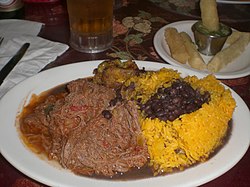


Shredded beef, also known as pulled beef, is a preparation of beef that features in dishes from various cuisines. Shredded beef is sometimes prepared using beef brisket [1] and chuck roast. [2] [3] Pot roast is also sometimes shredded. [4]



Shredded beef, also known as pulled beef, is a preparation of beef that features in dishes from various cuisines. Shredded beef is sometimes prepared using beef brisket [1] and chuck roast. [2] [3] Pot roast is also sometimes shredded. [4]